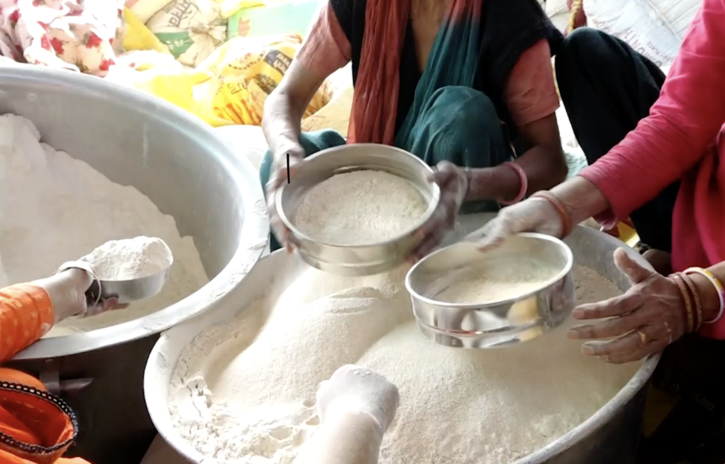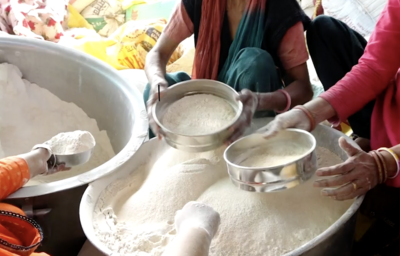Edited by: Rianna Lobo
Content warning: mentions of suicide
The farmers’ protest has only made Delhi inconvenienced since its emergence. While protesting farmers fear the eventual exploitation of capitalism, the rest of the country only fears the inconvenience of blocked routes and lengthy traffic jams. The bewilderment of it all is that this is not the first instance of the ‘free market’ interfering with the farming sector.
The courtship of capitalism and agriculture
“We’re committed to a world where biodiversity thrives in harmony with humankind.”
Bayer’s Crop Science site, India, offers this slippery promise on their homepage. Irony laughs at itself, for it was Monsanto (bought by Bayer in 2016) that set its foot in India with an illegal trial.
In 1997, the company started an illegal field trial for its cotton seed hybrid in India. The high yield and pest resistance attracted many; after all, the conditions of irrigation systems in India haven’t improved much since the 1960s, it is only natural to depend on something other than the rainfall. Skip to 2002, the exponential rise of these seeds across the cotton belt led to Monsanto’s convenient opportunity; collecting fees for a patent that does not exist.
The rise of prices in cotton seeds went up to 71,000% in 14 years. In 2016, the Indian government decided that this extortion of exorbitant fees is, in fact, not legal or justified. Thus, they decided to slash the royalty amounts by 70% (14 years later, in this duration, Monsanto had collected ₹ 4,479 crore in royalty between 2005-06 and 2014-15). Monsanto, now Bayer, (not much has changed apart from the name) filed a patent for its seeds in the apex court AFTER the royalties were slashed.
The patent itself is a form of travesty. In 2016-17, Monsanto sought to file a patent of the nucleic acid gene that made its seeds resistant to the worm (why would any industry let people have free access to life-saving resources, it is obviously meant to be sold at unfair prices.) /sarcastic/
The case is yet to reach its conclusion.
It is important to note that for many years after the introduction of the GMO seeds in India, Monsanto’s patent rights were shrouded in confusion.The company made vague statements regarding its IP rights, but never disclosed the patent numbers including in its sublicensing agreements. Thus, the Indian patent office as well as many activists working against Monsanto were unaware of these lies. No legal actions were taken against Monsanto for their lack of patent. No farming families were reimbursed.
Apart from this, Monsanto had been funding junk studies to discredit legitimate research about its cancer-causing herbicide, Roundup.
The name of Monsanto itself represents a divide within Indian society; most farming communities are no stranger to its name, yet the rest of the country is oblivious to the roots of a company prevailing in the country since the 1950s.
The ease we enable
Our economics books often discuss the entry of MNC’s in India in the late-1990s. Monsanto was yet another MNC with a gleaming promise in its hand, that of a higher yield of agricultural products than ever witnessed. The not-to-subtle courtship of capitalism took its path, flooding the Indian markets with Monsanto products. Their star performer, the glyphosate-based herbicide ‘RoundUp,’ is today sold in more than 125 countries. Most farmers use this herbicide with little or no protective gear; it seeps into the soil, the water table, and our collective diets.
Herbicide tolerance is a clever strategy. Ideally, it means that the plant (any weed) will not be affected by the herbicides used on it, eventually leading to its rampant growth and killing the crops. Herbicide tolerance usually develops when a particular type (in this case, RoundUp) is used for a long time, leading to building resistance against the chemicals. the only solution? Concentrated and overpriced chemical solutions. The resistance keeps building, RoundUp’s money keeps piling. It allows Monsanto to make a double killing, on the seed and then on the herbicide. Many farmers condemn the herbicide, as pests become more aggressive and turn resistant. This means that farmers have to bear the cost of buying even more chemicals.
The consistency of these seeds is another issue. While the promised output was achieved initially, the pests that these seeds are supposedly ‘resistant’ towards have adapted to the seeds themselves. What this essentially boils down to is the fact that farmers, in today’s day and age, are paying four times the price of the usual seeds to attain the same yield.
The United Nations-appointed body, the International Agency for Research on Cancer (IARC), reviewed glyphosate in 2015 after analyzing hundreds of studies from all over the world. IARC classified glyphosate as “probably carcinogenic” to humans. Monsanto is currently facing more than 9,000 lawsuits across the US from plaintiffs, mostly former gardeners and agricultural workers who believe that Roundup exposure caused their cancer. The whistle of ‘cancer train’ in Punjab still echoes in many ears, its warnings unheard.
While a few states have given the cry for banning the glyphosate-based weedicide (Maharashtra government communicated with the Union government to ban pesticides in 2018), most farmers’ organizations insist; “The authorities do not understand the ground realities. The farmers are using it only to make ends meet. Banning it without offering any alternative would further aggravate farm distress“. The reality, however, stays the same; without a chemical alternative to maintain their fields, the farmers are indebted to their dealer.
An obvious answer to these obstacles would be the assurance of a higher price, however, that seems to be a remote possibility. The farmers’ protest has succeeded in making it glaringly apparent that the state often deems advertising its achievements more important than the actual achievements.
Irrevocable losses
The farmers protest is not a first in any form. Tyrannical decisions on the other hand, have not been more obvious.
Maharashtra has substantial cotton production. Monsanto has a more substantial play in it, for they created the genetically modified cotton seeds widely used today. Farmers cultivating these seeds have spent nearly three times more on seed costs and significantly more on fertilizers and pesticides. A high price effect was majorly due to Monsanto collecting royalties for ‘technology’ out of every farmer’s wallet. This led to a rise in the debt taken up by each farming household. “In the past twenty years, Monsanto has been accused of contributing to more than 290,000 suicides.” Over 3.6 lakh Indian farmers have died by suicide since 1995 because of the distressed state of Indian agriculture. This works out to an average of 38 farmer suicides every single day for the last 26 years. Small, local farmers bear the weight of debt on their own because if a farmer wants a loan, he has to be using GMO seeds. The GMO seeds don’t show a consistent growth pattern across all Indian terrains.
Without a patent on Bt cotton seed Monsanto has been collecting royalties from farmers. Monsanto illegally introduced Bt cotton and claimed royalties, increasing the price of cotton seeds by 80,000 per cent. If that had not been enough damage, the compensation was never provided by the company, and their beloved /sarcastic/, overpriced seed went on to eradicate/damage upto 60% of soil-helping bacteria.
Since 1995, Monsanto has illegally monopolised seed availability in India, claimed money it had no right, and damaged the soil and water table.
Unlike farmers’ own seeds which can be freely saved and used the following year, farmers have to buy GMO seeds every year, which can cost up to four times more than traditional varieties. With a 90% market share in cotton-seeds, Monsanto has a tight grip on cotton growing in India. A harvest that does not yield much can send a farmer into debt. This debt then takes its roots deep into their lives, leading to depression and despair, suicide as their only out.
This is not an exaggeration. The Indian farmers have been dependent on the seed prices for twenty years. The cost of production is usually not met with MSP, with prices going as low as Rs. 1 per kg. The demand for making MSP a legal right is not the appeal for bare minimum, it is an appeal for the right to life.
The central Government, instead of providing aid, has successfully not kept up with rising inflation. The state offers loan waivers and relief packages; solutions for structural changes to the system are offered only on paper. It is evident that in India’s democracy, market forces have more rights than farmers’ lives, at least until the next elections. /hyperbole/
The extent to which the government cares about farmers is moving. Revolting moving. After all, it was a Karnataka minister that responded to the question of a farmer; “should we starve or die?”. The concern was regarding the lack of grains allotted by the government. The minister replied: “It is better to die. Karnataka minister, Umesh Katti, later defended himself by saying he did not assure the farmers because “I do not have such a big heart… I am a small-hearted person.” This is the country for small-hearted people, clearly. /sarcasm/
The three laws
A study by UNCTAD encompassing the mid-1980s to mid-2000s determined that farmers’ income (inflation-adjusted) had remained the same as in the 1980s. Yet another report by the Economic Survey, 2016 tells us that the average income of a farming family in 17 states of India, about half the country, is only Rs. 20,000 a year, or less than Rs. 1,700 a month. The country where landholding is limited to 4% of the farming population (read: zamindari and systematic caste oppression in the modern world.) The belief that free-market forces and commodity trading without any supporting subsidy or price ceiling will lead to the worst farming crisis yet, and every person protesting today sees this juggernaut hurling at us. In Europe, 50% of the subsidies are allocated for direct income support. The US gives $62,000 as subsidy support or an average to each farmer in a year.
Yet most advocates of free-market forces refuse to acknowledge that it is primarily subsidies that sustain whatever remains in agriculture today. The pretense of looking up at America for their success lies in the ability to ignore the deep cracks in our system.
The conflict of our lands
This protest is integral to all our lives, but it remains the dissent of a few.
The latest dataset on land grabs claims that 10 million hectares of land have been grabbed by foreign companies on average every year since 2007. The APMC Act (2003) made unprecedented provisions like direct purchase, contract farming and private wholesale markets (non-APMC). The contract farming found just a few takers, the direct purchase option was availed in modest ways by exporters, traders and supermarkets — and the private wholesale markets were often treated as a buzzing fly, often swatted and forgotten.
Once the APMC Act itself is revoked, the farming communities are stuck with fewer options and the pressure of keeping up with minimum wages as well as capitalist demands and profits.
A rising issue is that of the availability of market facilities. This obstacle was reported in Bihar, upon the removal of APMC Act in the state. The APMCs have long lent security to farmers. However low market prices go, they would always be able to sell at these government-run markets.
“Farmers reported they do not get a fair price for their agricultural produce. Most farmers also reported that the need for immediate cash after harvest, compels them to sell at a lower price to traders. Further, government market facilities are not available near the village.” The history of contract farming has many examples of non-payment by the companies. It has happened in the case of sugarcane in Bihar, where payments were held for many years with cases of non-procurement making excuses of poor quality. It had pushed millions of farmers into a debt trap. In such cases, the farmers are unable to repay the loans and have no option other than to sell/lose their lands. For the 68% of Indian farmers who own “small and marginal” land-holdings of less than 1 hectare, power relations with traders and contractors are even more intricate. That is why contract farming requires extensive regulation, because it is easier to demand low paid labour, as well as buying crops at a lower price, from many of these farmers. The farmers’ protest itself has under-represented their struggles.
The irony of support
“It will be the farmers themselves who will get the most benefit out of it,” the Prime Minister has argued, adding, “We should support each other.” The Prime Minister of India went on to defend the new farm bills, which include a potential lack of availability of minimum support price. “Even with an MSP, the prices received are always less because the produce is sold to middlemen or private players,” The government declares MSP for 23 crops, and government agencies procure wheat and paddy at MSP. Crops such as lentils, cotton and oilseeds do have MSP, but they are not procured by government agencies. The prices of other crops are determined by domestic and international demand-supply factors. However, the government itself is looking to remove commodities like cereals, pulses, oilseeds, edible oils, onion and potatoes from the list of essential commodities, under the essential commodities act 2020. An obvious reaction to this was the farmers protest and the eventual negotiations with the government. Yet, the supporters of this bill were asking the right questions, delivering us all from sin; ”Why are the farmers worried about the removal of MSP, when it is not on paper?” /sarcasm/
True priorities. /sarcasm/
The price itself has questionable priorities. For example, the subsidies encourage farmers in Punjab, a relatively dry area, to grow conventional rice, which requires a lot of water. Rice and wheat irrigation is depleting the area’s water table, according to India’s Central Groundwater Board.
The conclusion to our beginning
/sarcasm based paragraph/
The protests will surely die out.
That’s what most of us seem to believe in, anyway. It is a “new India” that the 3 laws have brought for us, the protests are evidently staving it off. Thus, the protests must be the root of the inconvenience. The traffic jams and the everyday news, the protests have affected them all, and so it is only expected that they must end soon. After all, it is a gimmick. To the privileged classes, most struggles and protests seem to be a gimmick. Everything seems to be politically motivated or formed through an unending stream of imaginary funds. It is convenient to forget that agriculture forms the largest employment base in our country.
/literal/
The fact that the laws weaken its already broken structure is not a hidden truth; it has been elaborated on by many, researched by a million more. This article refers to a small percentage of those studies, and yet, most of us seem to wait for the protests to die out. Once it has vanished from the mainstream media, it does not exist as a thorn, prickling our conscience. The chunk of India’s population (read: 250 million) sits on the borders of Delhi, voicing the demand for bare minimum for 44% of the country’s population.
All we had to do was form a chain of support.
All we do, however, is insist that the “general public” will soon forget this protest.?<ṇvc
Who forms this ‘general public’ is still a question that remains unanswered.
Sources: 1, 2, 3, 4, 5, 6, 7, 8, 9, 10, 11, 12, 13, 14, 15, 16, 17, 18
Legend
Bold – Important Phrases
Underline – Relevant Information
/ / – Tone Tags


